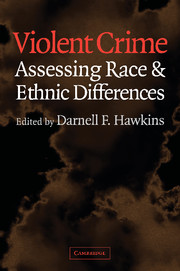Book contents
- Frontmatter
- Contents
- Contributors
- Foreword
- Editor's Introduction
- Violent Crime
- Part I Homicide Studies
- Part II Other Contexts, Settings, and Forms of Violence
- Part III Explaining Racial and Ethnic Differences
- 11 How Can the Relationship between Race and Violence be Explained?
- 12 “Race Effects” and Conceptual Ambiguity in Violence Research: Bringing Inequality Back In
- 13 The Violent Black Male: Conceptions of Race in Criminological Theories
- 14 The Structural-Cultural Perspective: A Theory of Black Male Violence
- 15 A Cultural Psychology Framework for the Study of African-American Morality and Violence
- 16 Racial Discrimination and Violence: A Longitudinal Perspective
- 17 Honor, Class, and White Southern Violence: A Historical Perspective
- References
- Index
13 - The Violent Black Male: Conceptions of Race in Criminological Theories
Published online by Cambridge University Press: 22 August 2009
- Frontmatter
- Contents
- Contributors
- Foreword
- Editor's Introduction
- Violent Crime
- Part I Homicide Studies
- Part II Other Contexts, Settings, and Forms of Violence
- Part III Explaining Racial and Ethnic Differences
- 11 How Can the Relationship between Race and Violence be Explained?
- 12 “Race Effects” and Conceptual Ambiguity in Violence Research: Bringing Inequality Back In
- 13 The Violent Black Male: Conceptions of Race in Criminological Theories
- 14 The Structural-Cultural Perspective: A Theory of Black Male Violence
- 15 A Cultural Psychology Framework for the Study of African-American Morality and Violence
- 16 Racial Discrimination and Violence: A Longitudinal Perspective
- 17 Honor, Class, and White Southern Violence: A Historical Perspective
- References
- Index
Summary
Violent crime has been a major problem in African-American communities for many years. Indeed, Uniform Crime Report (arrest) data indicate that African-American males have had significantly higher homicide rates than white males since at least 1930 (Reiss and Roth, 1993). Moreover, these differences have proven to be lasting, as recent arrest statistics indicate that African Americans, who make up 12 percent of the U.S. population, account for 57 percent of all homicide arrests (FBI, 1998; Harris and Shaw, 2000). And while the level of racial disproportionality is more modest for aggravated assaults, blacks still account for as many as 37 percent of aggravated assault arrests (FBI, 1998). Indeed, when blacks and whites are compared in terms of rates per 100,000, African Americans have homicide rates that are 8.8 times as high as those of whites and aggravated assault rates that are 3.9 times as high as white rates (FBI, 1998; Harris and Shaw, 2000).
Yet, violent crime rates do not simply vary by race. They also vary by the size and population density of a community. Hence, when violent crime rates are compared across cities, suburbs, and rural areas, large cities tend to have higher violent crime rates per capita than smaller cities, suburbs, or rural areas (Reiss and Roth, 1993). This has led a number of researchers to analyze the impact of race and urban residence simultaneously.
- Type
- Chapter
- Information
- Violent CrimeAssessing Race and Ethnic Differences, pp. 254 - 279Publisher: Cambridge University PressPrint publication year: 2003
- 6
- Cited by

